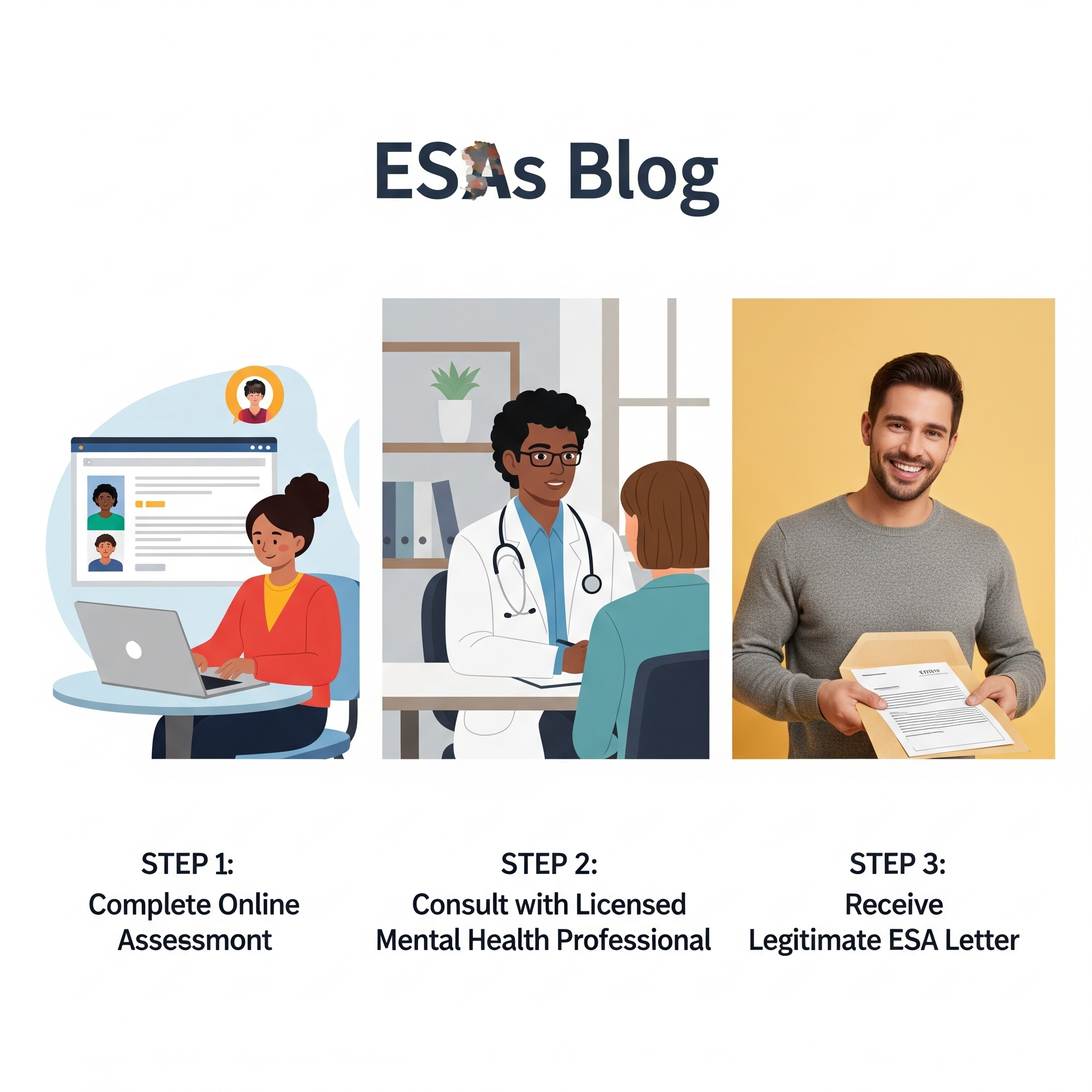For individuals living with mental health disabilities, a Psychiatric Service Dog (PSD) can be a transformative presence, offering critical support through trained tasks that mitigate their condition. Unlike Emotional Support Animals (ESAs), which provide comfort through their presence, PSDs are highly trained to perform specific, disability-mitigating tasks. This distinction leads to a common question: Is it easy to qualify for a PSD letter?
What Makes Qualifying for a PSD Different?
The primary difference lies in the definition and legal standing.
- Emotional Support Animals (ESAs): Provide comfort simply by their presence. Their primary legal protection is under the Fair Housing Act (FHA) for housing accommodations. An ESA letter typically requires a licensed mental health professional (LMHP) to determine you have a mental or emotional disability and that the animal provides support.
- Psychiatric Service Dogs (PSDs): Are trained to perform specific work or tasks that directly relate to an individual’s mental health disability. They have public access rights under the ADA, allowing them in places where pets are generally not permitted. The “task training” component is what elevates a PSD beyond an ESA.
The Two Core Requirements for a PSD Letter
To qualify for a legitimate PSD letter, you generally need to meet two fundamental criteria:
-
A Qualifying Mental Health Disability:
- You must have a mental or emotional disability recognized by the Diagnostic and Statistical Manual of Mental Disorders (DSM-5). This diagnosis must be made by a licensed mental health professional (LMHP).
- Examples of conditions that could qualify include (but are not limited to): severe anxiety disorders, panic disorder, PTSD, depression, obsessive-compulsive disorder, bipolar disorder, and schizophrenia.
- The disability must substantially limit one or more major life activities, such as sleeping, concentrating, communicating, or caring for oneself. This is a key legal threshold under the ADA.
-
A Need for a Task-Trained Dog to Mitigate Symptoms:
- This is the critical differentiator from an ESA. Your LMHP must determine that a dog trained to perform specific tasks is necessary to mitigate the symptoms of your disability.
- The tasks must be directly related to your mental health condition and be something you would otherwise struggle with. Examples include:
- Interrupting self-harming behaviors: Nudging, pawing, or licking to distract from picking, scratching, or cutting.
- Deep Pressure Therapy (DPT): Applying pressure to calm during anxiety or panic attacks.
- Room Checks/Crowd Control: Creating a barrier or checking rooms for individuals with PTSD or anxiety in public.
- Medication Reminders: Nudging or barking to remind handler to take medication.
- Guiding to an Exit: Leading a disoriented handler to an exit during a panic attack.
- Grounding: Providing tactile stimulation to help ground a person experiencing dissociation or flashbacks.
- Finding Help: Alerting another person or finding an emergency button during a crisis.
- Orienting During Disorientation: Helping a person with disorientation or a dissociative episode.
The Role of the Licensed Mental Health Professional (LMHP)
The PSD letter must be issued by a licensed mental health professional who has evaluated you. Their letter should:
- Confirm your qualifying mental health disability.
- State that the psychiatric service dog is necessary to assist you with tasks directly related to your disability.
- Include their license information and be on official letterhead.
Crucially, the LMHP does not certify the dog’s training. Their role is to verify your disability and the need for a task-trained dog. You are responsible for ensuring your dog is trained to perform those specific tasks.
Is Self-Training an Option for PSDs?
Yes, the ADA allows individuals with disabilities to train their own service animals. This means you do not have to go through a professional service dog training program, which can be incredibly expensive and have long waitlists. However, “self-training” still means the dog must meet the rigorous standards of a service dog:
- Public Access Manners: The dog must be well-behaved, house-trained, and under the handler’s control (e.g., no barking, jumping, or aggression in public).
- Task Proficiency: The dog must reliably perform the specific tasks it is trained for.
This self-training aspect is where the “ease” factor can be misleading. While you might not pay for a training program, the time, effort, and consistency required to train a dog to service dog standards are substantial.
Why Online Services for PSD Letters?
Just like with ESAs, reputable online telehealth platforms (like those used by CertifyESA, as discussed previously) can facilitate the process of obtaining a PSD letter. They connect you with licensed mental health professionals who can conduct the necessary evaluation remotely. This offers:
- Accessibility: Especially for those in remote areas or with mobility challenges.
- Convenience: Schedule appointments that fit your life.
- Privacy: Some prefer discussing sensitive issues in a telehealth setting.
However, the same caveats apply: ensure the service connects you with a licensed professional who conducts a proper evaluation. Avoid any site that claims to “certify” your dog’s training or offers instant approvals without a consultation.
FAQs About Qualifying for a PSD Letter
Q1: Do I need a specific breed of dog to qualify for a PSD? A1: No. The ADA does not restrict service animals by breed. Any breed or mix of breeds can be a PSD, provided they are trained to perform tasks and meet public access standards.
Q2: Does my PSD need to wear a vest or have special identification? A2: No. The ADA does not require service animals to wear vests, harnesses, or any specific identification. While some handlers choose to use them for clarity, they are not legally mandated.
Q3: Can my PSD go everywhere with me? A3: Generally, yes. Under the ADA, PSDs are allowed in most public and private places where the public is allowed (e.g., restaurants, stores, hotels, transportation). The only exceptions are typically sterile environments (like operating rooms) or where the dog’s presence would fundamentally alter the nature of the goods or services.
Q4: Can an airline ask for my PSD letter? A4: Yes, airlines can request documentation for psychiatric service dogs. While the U.S. Department of Transportation (DOT) no longer considers ESAs as service animals for air travel, PSDs (dogs trained to perform specific tasks for a mental disability) are still recognized under the Air Carrier Access Act (ACAA). Airlines typically require a DOT Service Animal Air Transportation Form and may ask for documentation from a licensed mental health professional.
Q5: What’s the biggest hurdle in qualifying for a PSD? A5: The biggest hurdle is usually the task training component. Many individuals meet the criteria for a mental health disability, but ensuring the dog is reliably trained to perform specific tasks that directly mitigate that disability, and maintaining those public access manners, requires significant commitment.
Q6: Can I get a PSD letter if I only have mild anxiety? A6: Qualification depends on the severity of your anxiety and how it substantially limits a major life activity. If your anxiety is mild and doesn’t significantly impact your daily functioning, it’s less likely to qualify you for a PSD. The LMHP must determine that a task-trained dog is medically necessary.
Qualifying for a PSD letter is requires a legitimate mental health diagnosis and a clear demonstration of need for a task-trained dog to mitigate your disability. While online services can simplify the letter acquisition process, the responsibility of having a truly task-trained and well-behaved service dog rests firmly with the individual.





